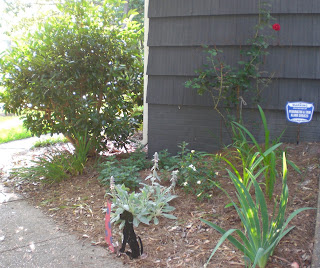The title of this post may sound like a horror movie, but only the latter part of it actually could be. What causes a vigorous squash plant to turn into the dead mess below in just one week?

A: Squash vine borers, a.k.a The Bane of My Existence. If your squash wilt like this, look for orange-
ish frass (looks similar to the cheap roe they use on
california rolls at lesser sushi restaurants) near the base. Wherever the
frass is, the borer is between that point and where the vine meets the dirt. Slit the vine with a knife, pick it (or them) out, and kill it. In the picture below, you can see
frass, the slit, and at the top of the slit, a borer.

Here is a smaller borer we picked out and
smooshed. They are pretty disgusting.

I had borers in almost all my vines. They say you can mound moist dirt over the slit and the vine may heal (though I'd just pull up a plant that looks as bad as the one above). They also say you can pile moist dirt over healthy stems and they may root at that point. I did both to be on the safe side. I also started more seeds so I can replace the plants if necessary. Supposedly in the deep south, there can be two borer seasons a year, so I may not be able to outsmart them by planting a second set of squash - we'll see!

Luckily suckers are not nearly as nefarious as borers! I'm pretty sure everyone who reads my blog knows how to spot a tomato sucker, but I had no idea when I started gardening, so here's a picture just in case. It's the tiny stem growing in the "v" between the main upright stem and the good sized branch on the right:

Suckers aren't bad if you have unlimited room to grow sprawling, gigantic plants. I don't, so I prune them out.
The thing about suckers is that they aren't just another branch; they're more like another entire tomato plant growing out of the side of your main plant! They are easy to spot at this stage, tougher later - though you can remove them anytime. Tomato plants are actually very forgiving about pruning. I control the height of mine as well as prohibiting suckers.
You can root your suckers in water if you want more plants - I usually let them get about 6 inches long before I cut them off the plant for that purpose.
One caveat about suckers: on some tomato plants, such as yellow pear, the stem on which blooms and babies will form comes from this same area or very close. It's easy to tell the difference, but I don't want you to prune out all your bloom stems by accident!
 Not all yard waste can be composted, however. Branches, for example, just take too long to decompose. So when this half-a-tree fell in our driveway last weekend, I found homes for some of its parts other than in the landfill.
Not all yard waste can be composted, however. Branches, for example, just take too long to decompose. So when this half-a-tree fell in our driveway last weekend, I found homes for some of its parts other than in the landfill. How about a tree trunk side table or garden stool?
How about a tree trunk side table or garden stool? Some things can be composted, but it's not advised - weeds that have gone to seed, anything especially invasive, etc. In the picture below, my neighbor's yard is on the left and mine is on the right. This undesirable vine was taking over my flower bed, so I kept pulling it up by the root and pulled it from my bed through (under) the grass and up to his bed, where apparently it originated. I cut it off at the edge of his bed, but it must have been 15 feet long at that point! (I could only find a 10 ft. tape measure)
Some things can be composted, but it's not advised - weeds that have gone to seed, anything especially invasive, etc. In the picture below, my neighbor's yard is on the left and mine is on the right. This undesirable vine was taking over my flower bed, so I kept pulling it up by the root and pulled it from my bed through (under) the grass and up to his bed, where apparently it originated. I cut it off at the edge of his bed, but it must have been 15 feet long at that point! (I could only find a 10 ft. tape measure) I sure didn't put that sucker in the compost! The perfect place for something like a root I don't want to re-root, as well as some of the tree branches from the fallen tree, is the back forty part of our yard where the compost lives. I pile up brush and branches there for birds and other small creatures to use for shelter. The simple pile is one of the reasons my yard is a Certified Wildlife Habitat! It's easy to do, makes birds happy, and cuts down on landfill use. Win-Win-Win.
I sure didn't put that sucker in the compost! The perfect place for something like a root I don't want to re-root, as well as some of the tree branches from the fallen tree, is the back forty part of our yard where the compost lives. I pile up brush and branches there for birds and other small creatures to use for shelter. The simple pile is one of the reasons my yard is a Certified Wildlife Habitat! It's easy to do, makes birds happy, and cuts down on landfill use. Win-Win-Win.
 Peruvian daffodils. These are so weird-looking - I love them!
Peruvian daffodils. These are so weird-looking - I love them!




 A: Squash vine borers, a.k.a The Bane of My Existence. If your squash wilt like this, look for orange-
A: Squash vine borers, a.k.a The Bane of My Existence. If your squash wilt like this, look for orange- Here is a smaller borer we picked out and
Here is a smaller borer we picked out and 

 Suckers aren't bad if you have unlimited room to grow sprawling, gigantic plants. I don't, so I prune them out.
Suckers aren't bad if you have unlimited room to grow sprawling, gigantic plants. I don't, so I prune them out. 






















